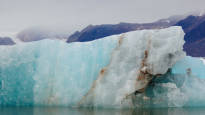Arctic ice provides information about what the earth’s climate was like in the past. The team of researchers recovered an ancient ice core from Huippuvuori, which contains up to 300 years of climate history.
Scientists race against time to collect samples of ancient Arctic ice. Permafrost is no longer forever: it must be recovered urgently now before the ice melts or changes as the climate warms.
For this purpose, a group of eight French, Italian and Norwegian researchers camped in Norway’s Svalbard archipelago this spring. The team of the Ice Memory Foundation was able to drill three huge pipes of glacial ice from there.
They, like the rest of the material from the project launched in 2015, are to be preserved for future scientific analysis at the Antarctic Research Station.
Analyzing the chemicals in the “ice cores” provides valuable information about centuries of climate and environmental conditions long after the original glacier has disappeared. Now experts are warning that as temperatures rise, meltwater will flow into the ancient ice and it threatens to destroy the geochemical information contained in the permafrost.
When the research team had drilled a hole about 25 meters deep in the Holtedahlfonna glacier of the Finnish Alps, water from the melting glacier rushed into it.
– We did not expect to find such abundant groundwater at the selected drilling site at the end of winter, admits the expedition coordinator Jean-Charles Gallet.
The changes in the north are dramatic
Reservoirs of fresh or salt water, called aquifers, are created inside glaciers. Their water penetrates the ice crystals and weakens them.
– Seeing all the water in the glacier gave us the clearest evidence so far of the dramatic effects of climate change in the Arctic region, says a member of the team Daniele Zannoni from Ca’ Foscari University of Venice.
When drilling continued at Holtedahlfonna, the researchers managed to extract three 50-75 meter long ice cores. The diameter of these translucent cylinders is only ten centimeters. The ice sheets and air bubbles in them can contain up to 300 years of climate history.
The glaciers are thinning
Human-caused carbon dioxide emissions have warmed the planet by 1.15 degrees Celsius since fossil fuel-based industrialization began in the 1800s.
Studies show that the Arctic region is warming two to four times faster than the global average.
On Friday, the UN announced that the world’s 40 so-called reference glaciers – those for which long-term observations exist – are now more than 26 meters thinner on average than they were in 1970.
Source: AFP
